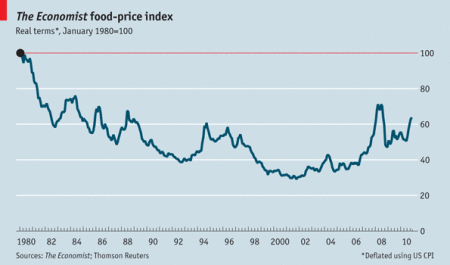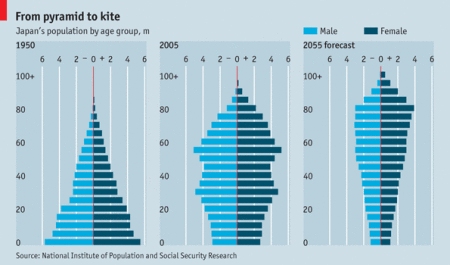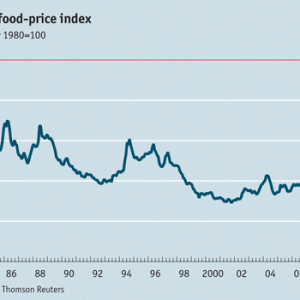The Economist publishes a “Daily Chart.” It’s a nice change of pace: the entire day’s post consists of a chart, and a paragraph explaining what the chart means.
I. Overpopulation is an Unfounded Fear
Two of these charts speak volumes about the overpopulation debate. Here’s the first, from November 17, 2010:

Malthus, if you’re not aware, is the founding father of overpopulation hysteria. He was convinced that at the pace people were reproducing, the world would quickly run out of resources like timber, and it would ultimately lead to mass starvation. In the twentieth century, folks like Paul Ehrlich claimed the same thing, selling countless books like Population Bomb fear-mongering (Ehrlich and others typically came from natural science backgrounds, and expected humans to behave like animals; this is almost certainly one of the major reasons they were so consistently wrong, and yet so convinced of their own predicted).
Ehrlich in particular claimed that food prices would go through the roof from the 1970s to the year 2000, even predicting the demise of England (no, seriously). Well, the chart above shows how profoundly wrong the neo-Malthusians were. Food prices are significantly cheaper than in 1980, and have been for each of the past thirty years.
II. “Gray-Out” is All Too Real
The second chart comes from November 19, 2010, and it tells the other side of the overpopulation story. Governments around the world encouraged birth control, sterilization, and abortion (sometimes voluntary, sometimes forced) in order to prevent the overpopulation they’d been convinced would occur. In reality, the threat these nations faced wasn’t too many children, but too few. One in particular, Japan, is now in a particularly perilous situation. As the Economist explains:
FOR about 50 years after the second world war the combination of Japan’s fast-growing labour force and the rising productivity of its famously industrious workers created a growth miracle. Within two generations the number of people of working age increased by 37m and Japan went from ruins to the world’s second-largest economy. In the next 40 years that process will go into reverse. The working-age population will shrink so quickly that by 2050 it will be smaller than it was in 1950, and four out of ten Japanese will be over 65. Unless Japan’s productivity rises faster than its workforce declines, which seems unlikely, its economy will shrink.

Watch the very bottom of the chart, since it show the number of children. In 1950, we’re looking at about 11 million Japanese under five; today, it’s closer to half that. With that few children, it’s going to be a real challenge for the next generation to create economic activity to provide for their aging parents, so it’s likely many young Japanese will fill unable to settle down and start a family, perpetuating the trend (the 2055 forecast shows this quite well, with only about 2 million Japanese under five). About the only two ways out are for the Japanese to start having a lot of kids, or for the nation to rely increasingly on non-Japanese workers, from groups who are having a lot of kids (and perhaps needless to say, this solution can lead to profound social instability in its own right, as we saw with Germany’s flirtation with cheap Turkish workers in the 1970s).
III. Conclusion
So basically, overpopulation – not a serious problem. The sky-is-falling predictions that overpopulation fanatics were trumpeting half a century ago (and in Malthus’ case, a few centuries ago) turned out to be radically incorrect. The theorists failed to account for the fact that with more human beings, you get more folks like Norman Borlaug (the man who single-handedly is believed to have saved a billion lives during his lifetime through the so-called “Green Revolution“). Turns out, with more people, you get more innovation and an overall better quality of life (which is why populated countries and metropolises tend to be better places to live than, say, Middle of Nowhere, Greenland).
On the other hand, underpopulation – a much bigger risk than most people realize. The economics here are solid, and the logic’s pretty irrefutable. Fewer kids today mean fewer workers tomorrow. And fewer kids today mean fewer potential parents tomorrow, which is why we see places like Japan with a downward population spiral. The population there’s actually falling, and there’s virtually nothing the government can do about it. Perhaps instead of worrying about butterflies (Ehrlich is a biologist by trade, with a specialty in studying butterflies), we should be worrying about the demographic tailspins of other industrialized countries, like Japan and much of Western Europe. Those risks – which are all too real, rather than ‘sound right on paper’ – are ones that virtually no one seems ready to face.

I like how my geography teacher at high school (a Catholic school – the teacher went to the weekly mass) described the opposite of a population pyramid a “population coffin”.
It’s sad but true. The West seems poised to kill itself, accomplishing a feat that its worst enemies, from the Nazis to the Communists, were unable to achieve.
Yes – it haunts me the way some people speak about children, like they’re a huge inconvenience that needs to be controlled and prevented at (almost) all costs.
These arguments all ignore the fact that every human has a decremental effect on the environment, and the boost of productivity you speak of as a product of human invention, comes at a cost of a huge boost in the per capita and total cost to the environment. Your shortsighted “solution” to the small problem of “too few young” to take care of aging parents, while true for a short period, will only be worsened, along with the environment, in the next generation. Economists, business executives, politicians, religious leaders all seem to wear “denial blinders” when it comes to the environmental costs of their greedy pronatalism. I consider this a sin against God’s creation
2Max,
You make three easily disproven claims:
1. “every human has a decremental effect on the environment”;
2. “the boost of productivity you speak of as a product of human invention, comes at a cost of a huge boost in the per capita and total cost to the environment”; and
3. “greedy pronatalism” is “a sin against God’s creation.”
Let’s take them in turn.
1. This is demonstrably and transparently false. You’ve made an absolute claim, that every human has a decremental environmental effect, when there are plenty of counterexamples which easily disprove you. Look at folks like Norman Bourlag or those currently helping transition our economy towards renewable energies. The effect of their individual lives serve as incalcuably large boons to the environment as well as your fellow man.
Even if you remove the “every” from your sentence, it’s still empirically false. If you were right, the evidence would be obvious: we’d expect to see environmental conditions progressively worsening as a direct result of our existence. In fact, we see the exact opposite. Humanity, on the whole, is improving the environment over how it looked two, three, four decades ago. The 2011 “Almanac of Environmental Trends” found this to be true for “(1) Air Quality, (2) Energy, (3) Climate Change, (4) Water Quality, (5) Toxic Chemicals, (6) Forests and Land, and (7) Biodiversity” (http://www.environmentaltrends.org/single/article/pri-releases-new-2011-almanac-of-environmental-trends.html). The Almanac simply compiles the hard data. And the hard data shows that your fear-mongering is scientifically laughable. And of course, this is starting from your implicit assumption that the environment is everybody else, and not us.
2. Here, you again are arguing against the full weight of the evidence. Development is net-beneficial for the environment. The reason that the environment has improved over the last few decades is largely a result of technology. For example, as we move away from burning coal and wood to nuclear, solar, and wind energies, we’re able to produce and consume far more energy (and everything else) with an ever-smaller environmental footprint. Likewise, the Green Revolution means that we can do the same for food production. We’re getting progressively more for progressively less. Obviously, there are some exceptions to this – the process of going from a Third World to a First World country involves some pollution. But as a long-term trend, there’s a reason that there are things like an Endangered Species Act in the West and not in the Third World. Namely, we’ve arrived at a place where we can afford to be environmentalists. If you were living in abject poverty, you couldn’t afford the self-righteous hand-wringing of complaining about industrialization while typing on your computer.
3. God Himself is a pro-natalist. Genesis 9:7, “As for you, be fruitful and increase in number; multiply on the earth and increase upon it.” Psalm 127 declares as blessed the man with many children (a “quiver full of them”). You get the idea. Short of telling God Himself that He’s being “greedy,” or committing a “sin” against His Creation by commanding us to be fruitful and multiply, and blessing those of us who do, you might want to reconsider this ill-conceived approach.
If you want to get past the sky-is-falling hype, and look at actual hard data (which is what economists and good scientists rely upon), an easily-accessible starting place (albeit a bit old) is Julian Simon’s Ultimate Resource II. As his bet with Paul Ehrlich proved, Simon’s views (the ones I’m arguing for) are massively better supported by reality than the discredited “population bomb” theory.